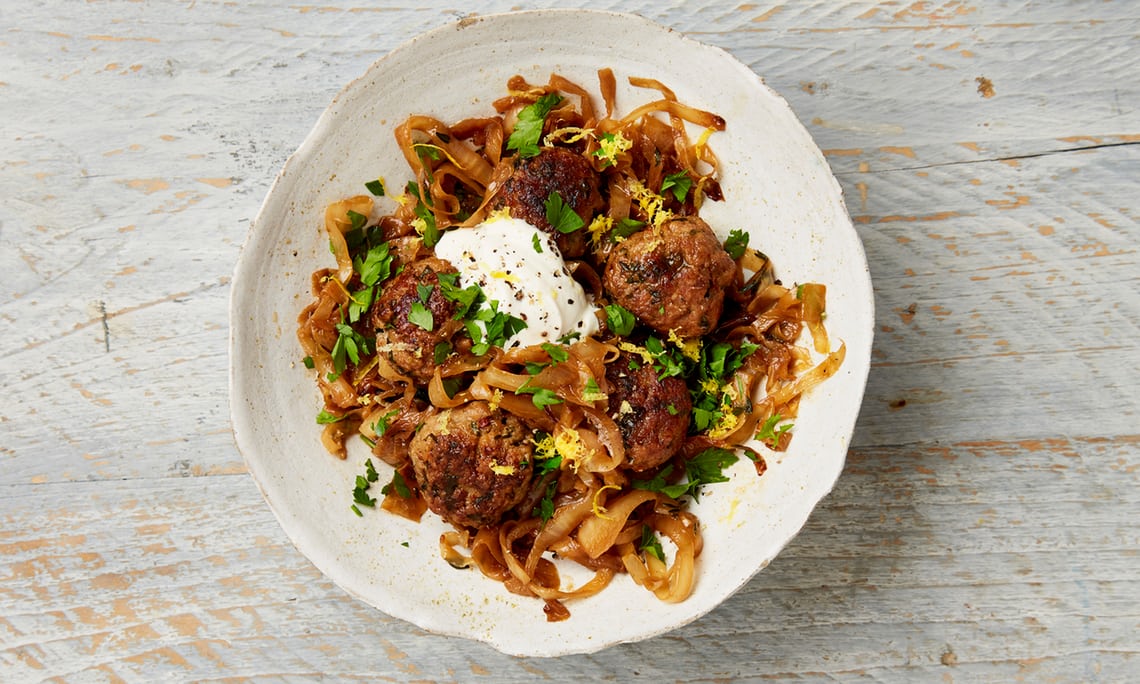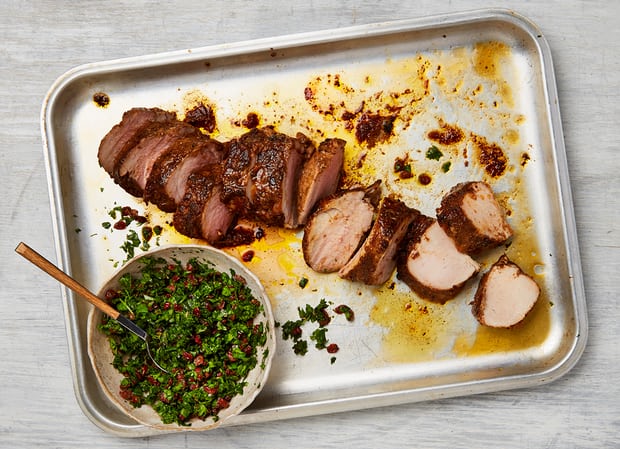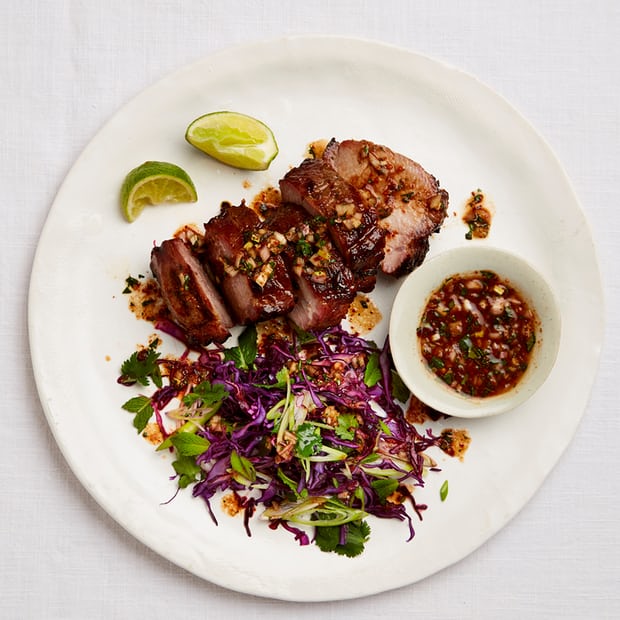Yotam Ottolenghi Pork Recipes
Pork can uphold the most intense flavours, making it versatile and perfect for an array of international dishes, from meatballs to a Chinese-Middle Eastern mashup
Pork lets you play with a range of ingredients that other meats simply won't tolerate. It's the fattiness of some cuts versus the relative leanness of others, allied to pork's rather neutral flavour – it's not beef, and definitely not lamb – that opens it up to ingredients as diverse as whisky, fish sauce, orange, caraway and ginger. I love this diversity – especially the ability to mix and match flavours on a global scale.
Caramelised cabbage and pork meatballs (pictured above)
 The tangy twist: Yotam Ottolenghi's pork meatballs with caramelised cabbage. Photograph: Louise Hagger for the Guardian
The tangy twist: Yotam Ottolenghi's pork meatballs with caramelised cabbage. Photograph: Louise Hagger for the Guardian
This works very well just as it is, but serve with mashed potato if you want an even heartier meal.
- Prep 12 min
- Cook 40 min
- Serves 4
- 400g pork mince
- 70g fresh breadcrumbs (from 2 slices white crustless bread)
- 2 garlic cloves, peeled and crushed
- 2 tbsp fresh thyme leaves
- 15g parsley, roughly chopped
- 2 tsp lemon zest (ie, from 2 lemons)
- ½ tsp ground cinnamon
- 1 tsp caraway seeds
- ½ tsp chilli flakes
- Salt and black pepper
- 1 tbsp vegetable oil
- 40g unsalted butter
- 1 cabbage, cut in half and then into 5mm-thick strips
- 2 tsp dark brown soft sugar
- 300ml vegetable stock
- 250g soured cream, to serve
In a large bowl, combine the mince, breadcrumbs, garlic, a tablespoon of thyme, a third of the parsley, a teaspoon of lemon zest, all the spices, a half-teaspoon of salt and a grind or two of pepper. Form the mix into roughly 20 walnut-sized balls, each weighing about 25g.
Heat the oil in a large saute pan on a high flame, then fry the meatballs (in batches, if need be) for about three minutes, turning them so they go golden brown all over, then transfer to a plate.
Return the pan to a high heat – don't worry about wiping it clean –and add the butter. Once it sizzles, add the cabbage and fry for 10-12 minutes, stirring occasionally, until caramelised and dark golden brown.
Stir in the sugar, the remaining tablespoon of thyme and a teaspoon of salt, then pour in the stock. Return the meatballs to the pan, turn down the heat to medium-low, cover and leave to simmer for eight minutes. Remove the lid, return the heat to high, and cook for four to five minutes more, until the liquid reduces to about 150ml.
Divide the cabbage and meatballs between four bowls. Mix the remaining 10g parsley with a teaspoon of lemon zest, and sprinkle on top. Serve with a generous dollop of soured cream.
Chinese five-spice pork with parsley and barberry salsa

The lean roast: Yotam Ottolenghi's Chinese five-spice pork with parsley and barberry salsa. Photograph: Louise Hagger for the Guardian
If you can, marinate the pork overnight to really get the flavours into the meat; if you're pushed for time, though, two hours will do. This same treatment would also work very well on chicken thighs. If you can't get hold of barberries, use chopped dried cranberries instead. Serve with herby rice and vegetables on the side.
- Prep 12 min
- Marinate 2 hr
- Cook 25 min
- Serves 4
- 1 tbsp Chinese five-spice
- 2 garlic cloves, peeled and crushed
- 1½ tsp paprika
- 5cm piece fresh ginger, peeled and finely grated
- 1½ tbsp maple syrup
- 60ml olive oil
- Salt and black pepper
- 1 pork fillet (about 500-600g)
- For the salsa
- 35g dried barberries, soaked for a few minutes in boiling water, then drained (or chopped dried cranberries)
- 45g parsley, picked and finely chopped
- 1½ tsp red-wine vinegar
- Finely grated zest of 1 large lemon, to get 1½ tsp
- 1½ tbsp olive oil
- 1 pinch caster sugar
- Flaked sea salt and black pepper
Put the first five ingredients in a large bowl with three tablespoons of oil, a teaspoon of salt and a good grind of black pepper. Add the pork, rub the marinade into the meat, then cover and refrigerate for at least two hours and ideally overnight.
Heat the oven to 180C/350F/gas 4. Heat a tablespoon of oil in a large frying pan on a high heat. Lift the pork from its marinade, then sear for about four minutes, turning often, so it turns golden brown on all sides. Transfer the meat to a roasting tray, spoon over the marinade and roast for about 10-15 minutes, depending on how well done you like your pork. Remove from the oven, cover with foil and leave to rest for five minutes.
Put all the salsa ingredients in a bowl with a third of a teaspoon of salt and some pepper, then stir to make a coarse salsa.
When you're ready to eat, carve the pork into 1.5-2cm-thick slices and divide between the plates. Spoon the cooking juices over the top, sprinkle lightly with salt and serve with the salsa spooned alongside or over the meat.
Thai marinated pork neck with nam jim sauce
 The Thai take: Yotam Ottolenghi's marinated pork neck with nam jim. Photograph: Louise Hagger for the Guardian
The Thai take: Yotam Ottolenghi's marinated pork neck with nam jim. Photograph: Louise Hagger for the Guardian
Pork neck fillet (which is also known as collar) is a very forgiving cut that has plenty of fat running through it (if you can't get hold of neck, use shoulder instead). The meat will really benefit if you can leave it in its marinade for two days, but four hours is the bare minimum. This is perfect served with boiled rice to soak up the sweet, sharp sauce.
- Prep 20 min
- Marinate 4 hr
- Cook 40 min
- Serves 4
- 100ml whisky
- 125ml fish sauce
- 150g soft light brown sugar
- 5 lemongrass stalks, trimmed, outer leaves discarded, then finely chopped
- 9cm piece fresh ginger, peeled and roughly chopped
- 1kg pork neck fillet
- 1½ tbsp vegetable oil, for grilling
- 1 lime, quartered
- For the nam jim
- 80ml freshly squeezed orange juice (ie, from 2 oranges)
- ½ tbsp basmati rice
- ¾ tbsp pul biber (Turkish chilli flakes) (or half that amount normal chilli flakes), gently toasted
- 20g tamarind paste
- 40ml fish sauce
- 1 tbsp maple syrup
- 1 shallot, peeled and finely diced
- 5g coriander leaves, finely chopped
- For the herb salad
- 150g red cabbage, or white cabbage, sliced radish or cucumber, finely shredded
- 2-3 spring onions, finely sliced on an angle
- 5g mint leaves, roughly torn
- 5g coriander leaves
Put the whisky, fish sauce and sugar in a medium pan on a medium-high heat and gently warm for a few minutes, until the sugar has dissolved. Add the lemongrass and ginger, turn off the heat and leave to cool completely.
Cut the pork against the grain into four 12cm-long and 6cm-wide pieces, then cut away and discard any silverskin. Transfer the meat to a non-reactive container that is just big enough to hold all the pieces in one layer, then pour over the cooled marinade and make sure the pork is well coated. Cover and refrigerate for at least four hours.
Heat the oven to 180C/350F/gas 4. Lift the pork from its container and dry well with kitchen towel (don't discard the marinade; it can be frozen and used again for marinating; alternatively, cook it down and, once reduced, use to glaze, say, chicken drumsticks). Brush each piece with a little oil and set aside. Ventilate the kitchen and put a griddle pan on a medium-high heat. Once the pan is smoking hot, lay in the pork pieces (in batches if need be) and cook for four to five minutes on each side, until golden brown and nicely marked with char lines (turn down the heat a little if it looks like the meat is starting to burn).
Put the browned meat on an oven tray lined with greaseproof paper, and roast for 10-12 minutes, until cooked through, then remove from the oven, cover with foil and leave to rest for 10 minutes.
While the meat is cooking and resting, make the nam jim. Put the orange juice in a small saucepan on a medium-high heat and simmer for about four minutes, until it's reduced to about 60ml, then leave to cool a little.
At the same time, toast the rice in a small saucepan on a medium-high heat for four to five minutes, until it starts to colour and smell nutty. Transfer the toasted rice to a spice grinder or mortar, add the chilli and blitz or pound to a coarse powder. Combine this with all the remaining ingredients for the nam jim and set aside.
Gently toss all the ingredients for the salad. Cut each piece of meat widthways into five, and serve warm with the herb salad, the nam jim poured over both of them and a lime wedge alongside.
Food styling: Emily Kydd. Prop styling: Jennifer Kay.